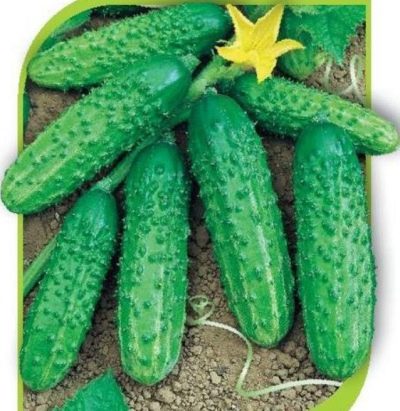
- Authors: Holland
- Name synonyms: Pasamonte
- Year of approval: 1997
- Growth type: medium-sized
- Fruit weight, g: 67-120
- Fruit length, cm: 6-9
- Fruit color: dark green with medium longitudinal stripes and moderate mottling
- Ripening terms: early
- Fruit shape: cylindrical
- Fruit taste: no bitterness, good
Pasamonte F1 is an early high-yielding cucumber variety. Therefore, it is so popular among ordinary gardeners who grow it in their private plots, and in farms.
Breeding history
The culture was obtained by the well-known agricultural firm Syngenta Seeds B. V. (Netherlands). The hybrid variety became popular in Europe almost immediately. And he came to our country in 1996, when the originators applied for admission to growing on the territory of the Russian Federation. After short variety trials, the hybrid was entered into the State Register, it happened a year later, in 1997. The variety was zoned in the Central and Middle Volga regions.
Description of the variety
Pasamonte is a parthenocarpic variety of the gherkin type. This means that the plant does not need pollination. Cucumbers are obtained with one-dimensional, small. The hybrid is grown both on open ground and in greenhouses.
Pasamonte cucumbers have several advantages:
- immunity to major cucumber diseases;
- fruits are not prone to overgrowth;
- self-pollinated variety;
- excellent taste characteristics;
- fruits are universal in terms of use, they are good in salting;
- long fruiting period;
- ease of care;
- high marketability of fruits.
Of the shortcomings, the obligatory fixation of the bush to the support is noted.
Characteristics of the appearance of plants and zelents
First, let's look at the features of cucumber bushes:
- medium-sized (from 2 to 2.5 m);
- average indicators of climbing and branching;
- light green or green leaves;
- good foliage, compact shape.
Zelentsy is distinguished by a number of features:
- these are short fruits 6-9 cm long;
- average weight - 67-120 g;
- the shape resembles a cylinder;
- the tubercles are large;
- the color is dark green, there are longitudinal stripes of medium length and spotting;
- classic cucumber taste,
- there is no bitterness;
- the pulp is juicy and crunchy;
- there are no voids inside the fruit.
Purpose and taste of fruits
Zelentsy Pasamonte are universal, they can be used for:
- summer salads and sliced;
- preparing snacks;
- salting;
- canning.
Maturation
An early hybrid from Holland ripens in just 40-42 days, if you count from germination to the appearance of the first greenery.
Yield
The average yield corresponds to the indicators of 269-329 c / ha.
Landing scheme
The hybrid can be cultivated in different ways. For example, many people grow Pasamonte through seedlings. And some sow directly to the garden bed inside their personal plot. Bushes are planted every 30 cm. The row spacing is 60-70 centimeters.
Growing and care
The main conditions for the successful cultivation of Pasamonte cucumbers will be as follows:
- loose light soil enriched with nutrients, such as loam or sandy loam, but without stagnant water;
- the air temperature at night should warm up to + 15 ° С;
- the best predecessors of cucumbers on the site are potatoes, tomatoes, cabbage, legumes.
Special requirements for the site:
- spaciousness, good illumination;
- lack of wind, drafts.
The agricultural technology of the culture under consideration is traditional.
- Top dressing.Pasamonte responds well to fertilizing with complex fertilizers, as well as minerals, organic matter (manure, droppings). They are held twice a month.
- Watering. Before flowering, the culture is irrigated 2-3 times a week, after the beginning of budding - 3-5 times. Use only warm liquid, 4-5 l / bush.
- Loosening. Plowing of the land, as well as weed removal, are carried out weekly. Improves aeration, helps control pests.
- Garter. Vines are tied either to a net or to a trellis structure.

In order to collect strong, tasty and beautiful cucumbers on your site, you need to make top dressing. Lack of nutrients can negatively affect the appearance of the plant and significantly reduce the yield. Fertilize cucumbers with organic fertilizers in combination with mineral fertilizers. With the right balance of these components and adherence to the fertilizing schedule, the cucumber yield will be maximum.
Disease and pest resistance
The culture has a strong immunity. The variety resists such ailments as the cucumber mosaic virus, ordinary powdery mildew. However, there is a small risk of infection:
- rot gray and white;
- anthracnose;
- downy mildew;
- root rot.
"Fundazol", as well as copper preparations, will help fight fungi.
Insect pests can attack:
- aphid;
- wireworms;
- nematodes;
- ticks;
- thrips.

Despite their popularity, cucumbers are often attacked by diseases and pests. From them, cucumber plantings often die before the start of fruiting. In order to prevent this from happening, it is necessary to try to prevent ailments or get rid of them at the very beginning, having studied in detail their causes of occurrence, signs and methods of treatment.





























































































